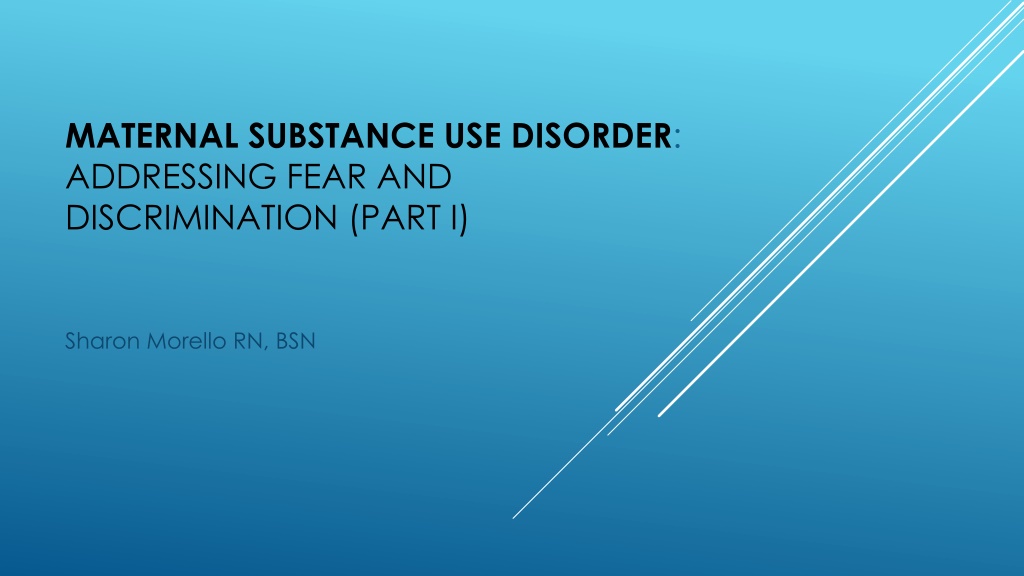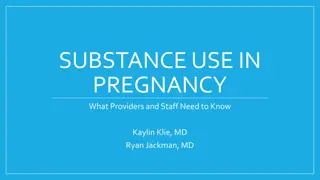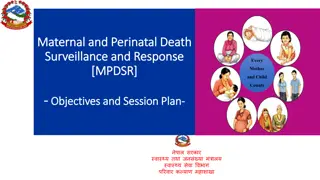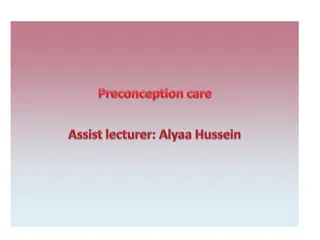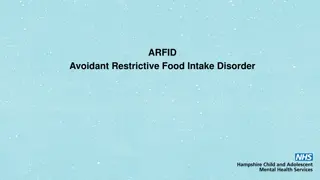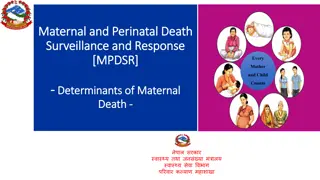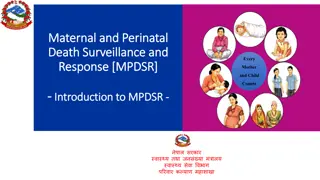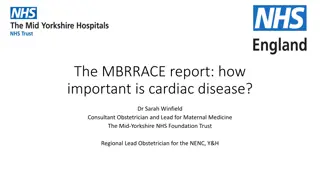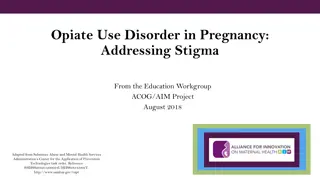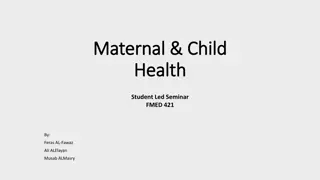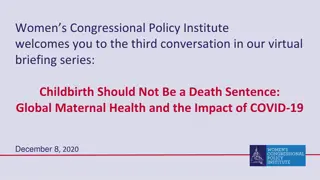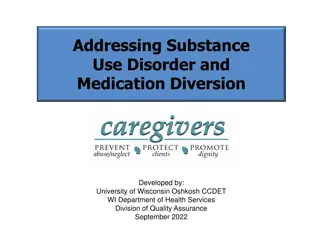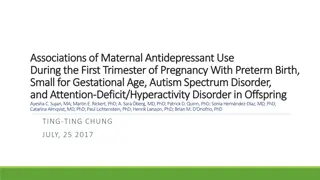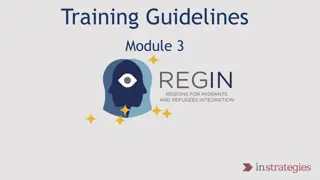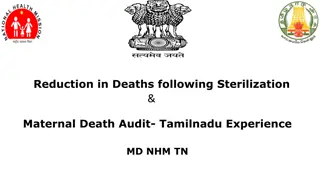Addressing Fear and Discrimination in Maternal Substance Use Disorder
This informative presentation by Sharon Morello, RN, BSN, sheds light on the pressing issue of substance use disorders among pregnant women. It discusses the opioid epidemic, heroin use trends, and the need to combat stigma and increase access to evidence-based care. The visuals included provide valuable insights and data to guide healthcare workers in addressing this critical public health challenge.
Download Presentation

Please find below an Image/Link to download the presentation.
The content on the website is provided AS IS for your information and personal use only. It may not be sold, licensed, or shared on other websites without obtaining consent from the author. Download presentation by click this link. If you encounter any issues during the download, it is possible that the publisher has removed the file from their server.
E N D
Presentation Transcript
MATERNAL SUBSTANCE USE DISORDER: ADDRESSING FEAR AND DISCRIMINATION (PART I) Sharon Morello RN, BSN
OPIOID EPIDEMIC AND SUBSTANCE USE DISORDERS
HEROIN USE CLIMBED THEN STABILIZED See table 7.2 in the 2017 NSDUH detailed tables for additional information and the 2017 CDC Mortality Data. PAST YEAR, 2002 AND 2015-2017, 12
SUBSTANCE USE AMONG PREGNANT WOMEN Special analysis of the 2017 NSDUH Report.
SOURCES WHERE PAIN RELIEVERS WERE OBTAINED FOR MOST RECENT MISUSE AMONG PEOPLE WHO MISUSED PRESCRIPTION PAIN RELIEVERS See figure 26 in the 2017 NSDUH Report for additional information.
Where Do We Need to Go From Here? TODAY! We have the science WE need to Advance theknowledge and Erase theSTIGMA and Erase theSTIGMA
WHAT IS ALREADY KNOWN ON THIS TOPIC? The rate for drug overdose deaths has increased approximately 140% since 2000, driven largely by opioid overdose deaths. After increasing since the 1990s, deaths involving the most commonly prescribed opioid pain relievers (i.e., natural and semisynthetic opioids) declined slightly in 2012 and remained steady in 2013, showing some signs of progress. Heroin overdose deaths have been sharply increasing since 2010.
23.5 MILLION AMERICANS CURRENTLY HAVE AN ADDICTION Only 10% in treatment 23 Million in people in recovery
AS HEALTHCARE WORKERS WE NEED TO BE LEADERS IN CHANGING THE TIDE OF THIS EPIDEMIC BY: Decreasing stigma Decreasing stigma Increase access to evidence Increase access to evidence- -based care, including Medication Assisted treatment including Medication Assisted treatment based care, Supporting expanded use of naloxone Supporting expanded use of naloxone Recognize and provide screening, brief Recognize and provide screening, brief intervention and referral to treatment (SBIRT) intervention and referral to treatment (SBIRT)
REDUCING STIGMA AMONG OUR PROFESSION AND IN COMMUNITY Know the facts Beware of your own attitudes and behaviors Choose words carefully Educate others Focus on the positive
THE SCIENCE OF ADDICTION There is a growing body of evidence of structural vulnerability of brains to the effects of intoxicating substances Several factors contribute to this Vulnerability: Genetics Early developmental influences and environmental factors Effects of stressful life events across the life cycle Mental disorders-principally depression and anxiety
WHO IS VULNERABLE? Persons most at risk for substance abuse and more so dependence, generally have higher rates of impulsivity, more difficulty managing negative affects- their moods and feelings The drug dependent person, even before ever using drugs, has brain characteristics that may predispose a vulnerability to the effects of mind-altering drugs. After a long period of using drugs, the addicted person ends up with a substantial altered brain- chemically and even anatomically Some people are born with imbalances of certain nuerotransmitters such as serotonin
BRAIN FUNCTIONING UNDER OTHER INSULTS-SIMILARITY TO ADDICTION The long-term effects of substance use and even long-term untreated depression can reduce frontal lobe functioning in the human brain The frontal lobes are where planning, executive functions, emotion management, and reasoning occurs- AND this is the area of that brain most needed for recovery activities In addition, head injuries can produce similar effects on the frontal lobes.
REWARD CENTER NATURAL REWARDS FOOD SEX EXCITEMENT COMFORT
THE BOTTOM LINE FROM THE SCIENTIFIC POINT OF VIEW Just say no is unrealistic It would be comparable to telling someone with diabetes, to just get over it Treatment may be need and may include medications to help the brain re-establish its equilibrium In fact, some people will need long term medications to offset genetic neurochemical problems or to help the brain to compensate for the lost substance. Some will need newer generation of anti-craving medications or replacement medications such as buprenorphine or Methadone Science suggests that the idea of moral deficiency is inappropriate and stigmatizing
Deaths Emergency Room Visits ER visits in August 2019= 162 From January to June =156 Total for this year January to August =1,086 July to October=52 (DATA not complete for these months) STATE DATA
Number of patients prescribed methadone for Opioid Use Disorder=5,921 Number of patients prescribed buprenorphine/naloxone for Opioid Use Disorder=5,419 Number of patients on Vivitrol for Opioid Use Disorder =158 NUMBERS IN RHODE ISLAND =11,498
RATIONALE FOR OPIOID USE DISORDER TREATMENT Medications prescribed for opioid use disorder Methadone Buprenorphine Why and how the body responds Stabilize neuronal circuitry Mu occupation/blockade Cross-tolerant, long acting, oral Prevent withdraw and craving Extinguish compulsive behavior Prevent spread of HIV and HCV Prevent criminal activity
MYTH There isn t any proof that MAT is the gold standard FACT: MAT is evidence-based (Many, many clinical trials since 1970 s -2000 s) and is the recommended course of treatment for OUDs. The National Institute of Dug Abuse, Substance Abuse Mental Health Services Administration, National Institute on Alcohol Abuse and Alcoholism, Center for Disease Control and Prevention and other agencies emphasize MAT as the first line of treatment
MYTH MEDICATION-ASSISTED TREATMENT SUBSTITUTES ONE DRUG FOR ANOTHER FACT: When properly prescribed, medications reduce drug cravings and prevent relapse without causing a high. Methadone and buprenorphine are opioid-based and result in physical dependence, but are fundamentally different from short- acting opioids such as heroin and prescription painkillers. The latter go right to the brain causing sedation and euphoria (a high ). In contrast, MAT medications help patients disengage from drug seeking and related criminal behavior and become more receptive to behavioral treatments. Injectable naltrexone is not opioid based and does not result in physical dependence.
MYTH Addiction medications are a crutch that prevents true recovery. FACT: Individuals stabilized on MAT can achieve true recovery, according to leading addiction professionals and researchers. This is because such individuals do not use illicit drugs, do not experience euphoria, sedation, or other functional impairments, and do not meet diagnostic criteria for addiction, such as loss of volitional control over drug use. MAT consists not only of medication but also of behavioral interventions like counseling. The medication normalizes brain chemistry so individuals can focus on counseling and participate in behavioral interventions necessary to enter and sustain recovery.
MYTH MAT SHOULD NOT BE LONG TERM. FACT: There is no one-size-fits-all duration for MAT. The Substance Abuse and Mental Health Services Administration ( SAMHSA ) recommends a phased approach, beginning with stabilization (withdrawal management, assessment, medication induction, and psychosocial counseling), and moving to a middle phase that emphasizes medication maintenance and deeper work in counseling. The third phase is ongoing rehabilitation, when the patient and provider can choose to taper off medication or pursue longer term maintenance, depending on the patient s needs. For some patients, MAT could be indefinite.8 The National Institute on Drug Abuse ( NIDA ) describes addiction medications as an essential component of an ongoing treatment plan to enable individuals to take control of their health and their lives. For methadone maintenance, NIDA states that 12 months of treatment is the minimum.
BENEFITS OF PHARMACOTHERAPY FOR PREGNANT WOMEN WITH OUD Pharmacotherapy is a critical element in the treatment of OUD for pregnant women. Pharmacotherapy helps patients with OUD avoid Experiencing withdrawal symptoms. Overwhelming cravings when the opioid misuse is stopped. Pharmacotherapy can help pregnant women stop Injecting drugs, a primary route of infection for people who use drugs. Risky behaviors associated with drug acquisition.
Overarching Recommendations Buprenorphine and methadone are the safest medications for managing OUD during pregnancy Medically supervised withdrawal is not recommended during pregnancy Transitioning from methadone to buprenorphine or from buprenorphine to methadone is not recommended Breastfeeding is recommended for women on buprenorphine and methadone NAS should not be treated with dilute tincture of opium https://store.samhsa.gov/product/SMA18-5054
